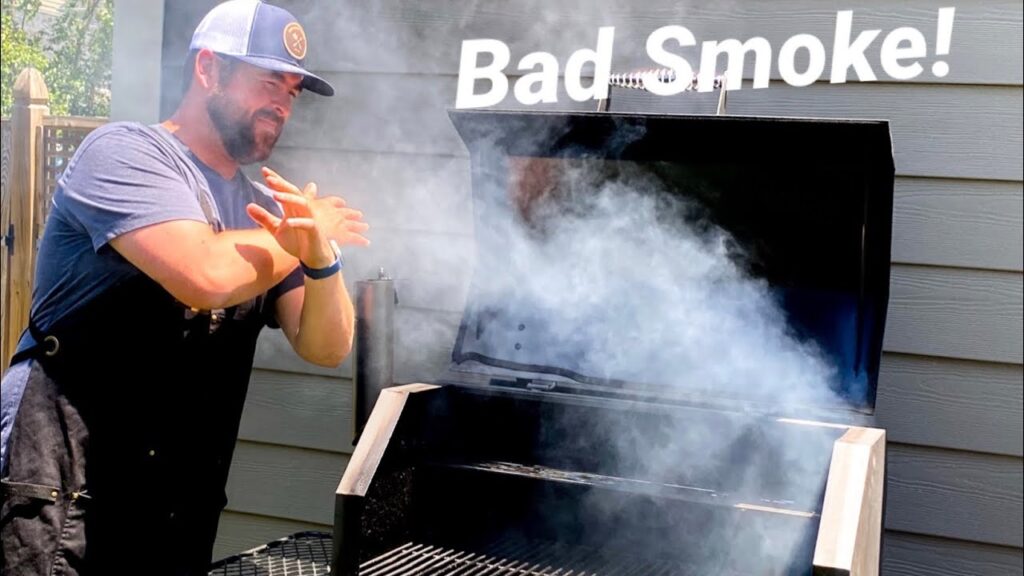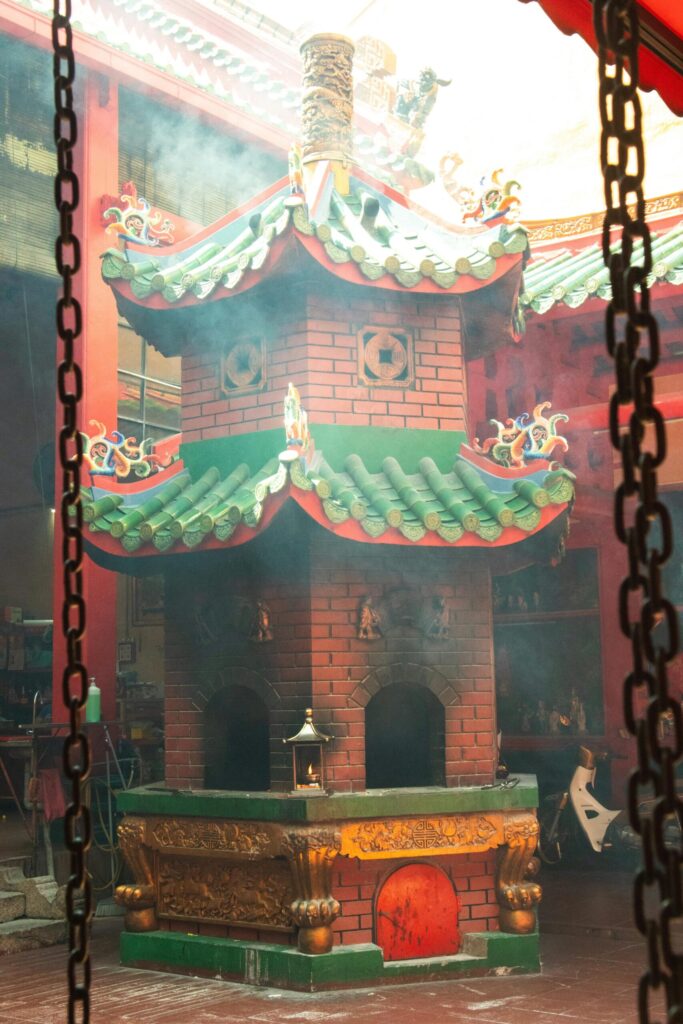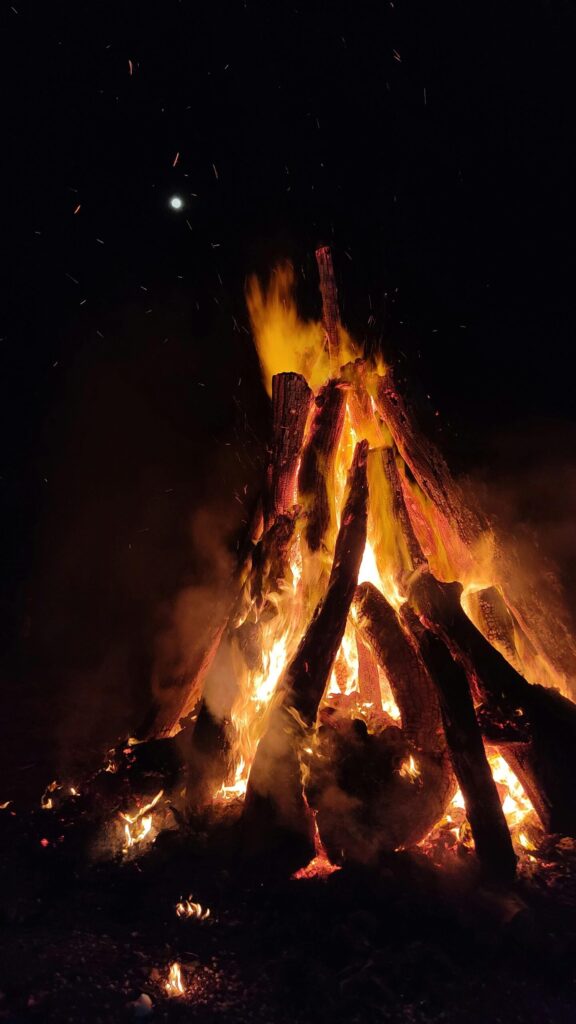In “BBQ White Smoke Versus Dirty Smoke Troubleshooting Guide” you’ll learn why thick white smoke isn’t always a sign of success and how dirty, sooty smoke can ruin flavor and safety. The guide helps you spot good versus bad smoke, fix common fuel and airflow mistakes, and set up your Kingsford Stockade 49 or similar smoker for cleaner, more controlled smoking.
You’ll get a clear roadmap: step-by-step setup and vent control, fuel and wood selection tips, cleaning and grease-management routines, troubleshooting checks to stop bad smoke, and safety best practices to protect you and the gear. Follow the checklist sections and practice the adjustments to gain confidence and consistent results on your next smoke.

This image is property of i.ytimg.com.
Short introduction that explains the purpose of the guide and why it matters for safe, flavorful smoking
You want clean, predictable smoke because it directly affects flavor, safety, and how long your smoker lasts. This guide condenses practical, video-based advice into clear steps and explanations so you can recognize good smoke, avoid bad smoke, set up and season your smoker, control vents, and maintain your equipment. Follow these pointers and you’ll reduce off-flavors, lower safety risks, and get more consistent results from your Kingsford Stockade or similar offset smoker.
Reminder: exclude recipes and food-prep instructions
This guide focuses on equipment, technique, troubleshooting, and safety. It does not include recipes, ingredient lists, or step-by-step food preparation—those belong in separate resources.
Step-by-step instructions or tips summarized from each video or playlist in plain language
Assembly & initial inspection (what to check before first use)
When you unpack a smoker like the Kingsford Stockade, check that gaskets, smoke locks, dampers, grates, and the grease management components are present and seated correctly. Assemble the unit on a stable, level surface with good clearance from structures. Verify that wheels and locking casters work, the ash pan slides freely, and the offset firebox door seals tightly. Hand-tighten fasteners, confirm that vents move smoothly, and place grates in their intended positions before your first burn.
Burn-off and seasoning (how to remove factory residues and stabilize metal)
Start with a controlled burn-off: build a medium-hot fire and run the smoker empty for a few hours to burn away manufacturing oils, paints, or contaminants. Use a chimney starter for lump charcoal or briquettes and establish a steady, hot fire. Maintain airflow so the smoke is thin and bluish during this process. After the initial high-heat burn, perform several lower-temperature seasoning burns to coat cooking surfaces with a thin layer of polymerized oil from neutral-smoke heats—this helps seals and protects the interior.
Fire management and lighting (chimney technique and startup)
Use a charcoal chimney to light fuel quickly and evenly; dump fully ignited coals into the firebox and arrange them for the airflow pattern you need. Avoid adding unlit, wet, or oversized fuel directly on top of embers—this causes smoldering and heavy white or black smoke. Start with a smaller, hotter fire to establish clean combustion, then adjust vents to dial back to the desired low-and-slow temperature once smoke clears to a thin blue.
First cook review and learning from initial runs
After your first cook, inspect how smoke behaved, where grease dripped, and whether seals leaked. Note hot and cool spots on the cooking grate and how frequently you adjusted vents or added fuel. Use photos or a short log entry to capture timing, vent positions, and fuel amounts—those notes are valuable when you troubleshoot next time.
Never-do list for offset smokers (common beginner mistakes)
Don’t overload the firebox with unlit or wet wood, don’t stuff the smoker with unseasoned green logs, and don’t close vents completely once you’ve got a live bed—those habits cause smoldering and creosote buildup. Avoid burning treated or painted wood and don’t place the smoker too close to combustible structures. Also, don’t neglect the grease bucket and drip paths; overflowing grease causes flare-ups and smoke issues.
Explanations of key concepts such as good smoke vs bad smoke, creosote, vent control and combustion chemistry
Good smoke vs bad smoke
Good smoke is thin, almost invisible to slightly bluish, and delivers clean flavor without acrid or chemical notes. Bad smoke is thick, white or black, and often carries a sharp, unpleasant smell that can ruin food. Good smoke results from hot, complete combustion of dry, seasoned fuel; bad smoke is a sign of incomplete combustion, contaminated fuel, or excessive moisture.
Creosote
Creosote is a dark, sticky, tar-like byproduct of incomplete combustion and condensed organic vapors. It forms on cold surfaces inside the smoker, in chimney flues, and on food when smoke is heavy and cool. Creosote tastes bitter and chemical-like, accelerates deterioration of metal and seals, and increases fire risk when allowed to accumulate.
Vent control and combustion chemistry
Combustion needs fuel, oxygen, and heat. You control oxygen with intake and exhaust vents; more oxygen raises temperature and promotes complete combustion (thin blue smoke), while restricted oxygen leads to lower temperatures, smoldering, and dirty smoke. Heat drives the volatile compounds from wood; with proper airflow these volatiles burn cleanly. Balancing intake (oxygen) and exhaust (draft) is how you move from white or acrid smoke to clean blue smoke.
Safety advice and best practices relevant to startup, fuel handling, and carbon monoxide risks
Safe startup practices
Always start your smoker outdoors in a well-ventilated area, away from overhangs and buildings. Wear fireproof gloves and use long-handled tools. Keep a fire extinguisher or bucket of sand nearby and ensure children and pets are kept at a safe distance. When lighting fuel, build a compact, controlled fire—don’t use accelerants or indoor lighting methods.
Fuel handling safety
Store wood and charcoal in a dry, ventilated place off the ground to prevent moisture and mold. Handle lump charcoal and briquettes carefully—charcoal dust can combust if ignited in confined spaces. Use a chimney starter rather than lighter fluid whenever possible to avoid chemical residues and flare-ups.
Carbon monoxide and ventilation
Never run a smoker inside a garage, tent, or enclosed area. Combustion produces carbon monoxide (CO), a colorless, odorless gas that can be deadly if it accumulates. If you’re smoking in a semi-enclosed space, ensure cross-ventilation and keep fuel-burning equipment outdoors. Install a CO detector in adjoining living spaces if you regularly smoke near semi-enclosed areas.

This image is property of images.pexels.com.
Maintenance and cleaning routines to prevent dirty smoke and extend equipment life
Daily and after-cook cleaning
After each use and once the smoker has cooled, remove ash from the firebox and ash pan to maintain airflow and prevent damp ash from smothering coals. Empty the grease bucket and clean drip pans to avoid overflow and smoke from burning grease. Wipe grates clean or brush them before and after each cook to prevent buildup.
Periodic deep cleaning
Every few months, or after heavy use, remove grates and interior racks and scrape accumulated carbon and creosote from chamber walls, smoke locks, and flues. Clean grease traps and inspect the grease management system for blockages. Check gaskets and replace if they are compressed or leaking.
Preventing dirty smoke through maintenance
Regular cleaning reduces the surfaces where creosote and soot can condense and later release dirty smoke. Replace rusted or warped grates, maintain a level fire grate to prevent fuel from smothering, and ensure vents and smoke locks are free of ash or grease that can obstruct airflow.
Fuel storage and handling to prevent moisture problems
Keep wood and charcoal covered and elevated. If wood has gotten damp, let it dry thoroughly before burning or avoid using it for smoking. Store lump charcoal in a sealed container or dry place to prevent moisture absorption.
Conclusion that encourages practice, confidence, and links to further video resources
Recap: focus on establishing clean combustion during startup, choose dry, seasoned fuel, control intake and exhaust to get thin blue smoke, and maintain your smoker to prevent creosote and dirty smoke. Practice vent control and seasoning burns until you can reliably get clean smoke before you place food inside. Stay safe—use proper gear, treat fuels responsibly, and never run the smoker indoors. For step-by-step visual help, watch manufacturer videos and trusted tutorials on seasoning and vent control to reinforce these techniques. Keep a cook log, join communities, and practice regularly to build confidence and consistency.

This image is property of images.pexels.com.
Understanding white smoke versus dirty smoke
Definition and characteristics of white smoke commonly seen during startup or damp fuel burn
White smoke is typically light-colored, sometimes steam-like, and often produced when water or sap in the fuel vaporizes. During startup, white smoke can be a normal transitional phase as fuels heat and moisture is driven off; it is generally thinner and disperses quickly when combustion stabilizes.
Definition and characteristics of dirty smoke, including creosote-laden, acrid, or black smoke
Dirty smoke is thick, dark, and often smells pungent or chemical. It usually indicates incomplete combustion or burning of contaminated materials (painted, treated, or resinous woods). Creosote-laden smoke is sticky, acrid, and imparts bitter flavors while also depositing tar on smoker surfaces.
How white smoke and dirty smoke differ in smell, color, density and potential impact on food flavor
White steam-like smoke smells faint and sometimes slightly sweet if sap is present; it’s low density and dissipates quickly. Dirty smoke is denser, dark gray to black, and smells sharp, bitter, or chemical. White moisture-driven smoke may affect surface moisture but not necessarily flavor, while dirty smoke can ruin flavor and make food taste bitter, burnt, or chemically tainted.
Why distinguishing smoke types matters for food safety, flavor, and equipment longevity
Telling the difference lets you decide whether to wait before introducing food, adjust vents, or clean the smoker. Allowing dirty smoke to continue will taint flavor, speed creosote buildup, and shorten the life of seals and metal components. Recognizing acceptable white smoke during startup helps avoid unnecessary delay while preventing the acceptance of truly harmful smoke types.
Identifying smoke visually and by smell
Thin blue smoke indicators and why it is the goal for clean smoking
Thin blue smoke is the hallmark of complete combustion with little particulate matter; it’s almost translucent and can have a slightly sweet, pleasant wood aroma. You should aim for this smoke when food goes on the grate because it deposits desirable aromatic compounds without bitter tars.
Heavy white smoke indicators and when it is acceptable versus problematic
Heavy white smoke that looks like steam is acceptable early in the startup as moisture exits fuel, but it should clear within a few minutes to an hour depending on fuel moisture and heat. If heavy white smoke persists long after the fire is established, it likely indicates wet fuel or a cooling fire and needs correction.
Thick black smoke and acrid odors as signs of incomplete combustion or contaminants
Thick black or gray smoke with acrid, chemical smells is a red flag. It points to incomplete combustion, burning of treated or contaminated materials, or a smoldering firebox. This smoke will ruin flavors and deposit harmful residues; you should shut down the cook, resolve the fuel issue, and clean affected surfaces.
Practical tips for observing smoke (angle, background contrast, smell testing without inhaling) and documenting with photos or video for troubleshooting
Use a neutral background (sky or light wall) and view smoke at arm’s length so you don’t inhale. Hold your nose upwind and avoid breathing directly into the smoke; briefly waft smoke toward you with a hand to assess smell. Photograph or video smoke from a few angles and note wind conditions, fuel, and vent settings—these records help you diagnose recurring problems.

This image is property of images.pexels.com.
Common causes of heavy white smoke
Excess moisture in fuel, soaked wood, or wet charcoal causing steam-heavy white smoke
Wet fuel drives off water as steam, producing a visible white plume. The steam cools combustion zones and promotes smoldering, so always use dry, seasoned wood and dry charcoal to avoid persistent white smoke.
Cold startup and low-temperature smoldering before full combustion begins
A cold smoker and cool fuel bed can lead to long periods of white, clinging smoke as volatiles heat slowly. Use concentrated initial heat from a chimney starter or a smaller hot bed to reduce this transitional period.
Green or unseasoned wood containing sap and moisture that produces steam and white emissions
Fresh-cut or “green” wood contains sap and high moisture which vaporizes and produces heavy white smoke with a sweet but often harsh flavor impact. Avoid green wood for smoking.
Large amounts of grease or water dripping onto hot coals creating steam and white vapor
Grease or water that falls onto hot coals can create bursts of white steam and sometimes splatter that contacts fuel and smolders. Manage drip paths and use baffles or drip pans to keep liquids from hitting the fire directly.
Common causes of dirty or bad smoke
Smoldering wood and overloading the firebox, producing creosote-rich, acrid smoke
If you overload with unlit wood or restrict airflow, fuel smolders and releases volatiles that condense as creosote. Load in measured amounts and allow oxygen to flow to keep combustion clean.
Burning treated, painted, or manufactured wood and other contaminants that create chemical smoke
Never use treated, painted, or pallet wood; those materials release toxic and foul-smelling compounds. Only burn food-safe, untreated wood or purpose-made smoking fuel.
Running at too-low temperatures or insufficient airflow causing incomplete combustion
Low-temp fires lack the heat to fully oxidize volatile compounds, producing thick, acrid smoke. Adjust vents and fuel to reach a combustion zone hot enough for clean burning, then reduce to cooking temps with balanced airflow.
Using inappropriate fuels such as wet pellets, painted pallets, or damp charcoal briquettes
Inappropriate or contaminated fuels introduce unknown chemicals and excess moisture. Use fuels specified for cooking and check packages and storage conditions before burning.
Fuel and equipment selection best practices
Choosing seasoned hardwoods and food-safe wood species for predictable smoke quality
Select hardwoods that are properly seasoned for at least six months, with moisture content ideally below 20%. Fruitwoods and traditional hardwoods offer predictable, pleasant smoke profiles, but focus first on dryness and food-safe sourcing.
Selecting quality lump charcoal versus briquettes depending on your smoker design
Lump charcoal lights hot and clean with less filler, making it a good choice for direct fire and offset smokers when you want quick, hot burns. Briquettes provide steady, long-lasting heat but can contain binders—choose food-grade briquettes and be aware they might produce more ash.
Avoiding treated, painted, or resinous woods and non-food safe fuels
Only use unadulterated, natural wood or approved smoking fuels. Stay away from pressure-treated, painted, or chemically treated lumber and avoid burning garbage or plastics.
Essential tools: charcoal chimney starter, ash rake, long-handled tongs, fireproof gloves, and quality thermometers
A chimney starter gets fuel hot fast without chemical starters. An ash rake and long tongs let you manage coals safely. Fireproof gloves protect you during adjustments. Invest in accurate air- and meat-temperature thermometers so you can tune combustion and cooking without guessing.
Kingsford Stockade and other smoker-specific setup tips
Key Stockade features that affect smoke control: offset firebox, smoke locks and gasket, grease management system
The Stockade’s offset firebox creates a long path for smoke and heat, so proper loading and venting are crucial. Smoke locks and gaskets reduce leakage and help maintain stable internal temperatures. The grease management system collects drips—keep it clean to avoid smoke from burning grease.
Assembly and initial inspection steps to ensure seals, smoke locks and dampers are installed correctly
On assembly, inspect gasket seating on doors, test smoke locks for smooth operation, and confirm dampers open and close freely. Make sure the ash pan has clearance and the fire grate sits level to encourage even airflow.
Firebox loading patterns for the Stockade to encourage clean burn and prevent smoldering
Load the Stockade’s firebox with a base of hot coals and add wood gradually. Place logs so air can circulate around them and avoid stacking unlit logs on a small bed of embers. Build a two-tier layout: a hot coal bed near the intake and larger logs further away to maintain even burn.
Checks to perform before first use: gasket seating, vent movement, grate placement, and ash pan clearance
Before igniting, verify that gaskets compress evenly, vents move without binding, grates are seated securely, and the ash pan is accessible. Confirm the grease bucket is in place and that the smoker is level to prevent unintended grease pooling.
Startup, burn-in and seasoning procedures
Chimney lighting technique and how to get a hot, clean burn quickly
Fill a chimney with lump charcoal or briquettes and light with natural starters. Wait until coals are gray and hot, then pour into the firebox. Arrange coals to create a concentrated hot zone and add small wood pieces to encourage quick ignition of volatiles and minimize white steam.
Burn-off and seasoning steps for new smokers to remove manufacturing residues and establish stable combustion
Run an initial high-heat burn for several hours with vents open to oxidize paints and oils. After that, perform a few lower-temperature seasoning burns—maintain clean blue smoke and allow thin oil film from neutral fats or vegetable oil to polymerize on cooking surfaces to protect metal and create a nonstick layer.
How to achieve clean blue smoke before placing food on the grate and why that matters
Wait until white or heavy smoke has cleared and the smoke becomes thin and slightly bluish—this indicates stable combustion. Placing food too early exposes it to moisture and creosote, causing off-flavors and increased soot deposition.
Common beginner mistakes during startup such as overloading with fuel or covering vents too early
Beginners often add too much unlit wood, smother vents to “contain” heat, or put food on while smoke is still dense. These actions create smoldering fires and dirty smoke. Start with less fuel, maintain airflow, and be patient until smoke is clean.
Vent control and airflow management
Basic principles: intake brings oxygen, exhaust removes combustion gases and controls draft
Open intake increases oxygen and fire intensity; exhaust must be open enough to allow gases to exit and draw fresh air through the fire. The balance between intake and exhaust controls temperature and smoke character.
How to adjust intake and exhaust dampers to move from white/dirty smoke to thin blue smoke
If you see white or dark smoke, incrementally open the intake to add oxygen and nudge the fire into a hotter, cleaner burn. Open the exhaust slightly to improve draft and remove volatile gases. Make small adjustments and observe changes over 10–15 minutes.
Using two-zone fires and indirect cooking strategies for steady low-and-slow temperatures
Create a hot side with concentrated coals and a cooler side for indirect cooking. Place food on the cool side and use vents to stabilize temperature. Two-zone setups let you add coals or wood without exposing food to direct flame and help maintain cleaner smoke.
Practical vent adjustment sequence and when to tune vents in response to smoke color or temperature changes
Start with both intake and exhaust open to establish fire, then partially close to hit target temp while keeping smoke thin. If smoke darkens or thickens, open intake a bit and crack exhaust to restore draft. Tune every 10–20 minutes when conditions change, and use thermometers to guide decisions.
Conclusion
You now have a full, practical roadmap to recognize and correct white versus dirty smoke, set up and season your smoker, control airflow, and maintain equipment for safe, flavorful smoking. Practice the startup, vent adjustments, and maintenance routines until you develop muscle memory—small, consistent changes matter more than dramatic corrections. Always prioritize safety: handle fuels carefully, keep the smoker outdoors, use protective gear, and monitor for carbon monoxide risks. Next steps: follow video tutorials for visual reinforcement, participate in owner communities to share tips, and keep a cook log so you can learn from each session. With patience and practice, you’ll develop the control to produce that thin blue smoke that makes smoked food taste its best.
